跨文化交际学-9
大学生英语跨文化交际复习题库
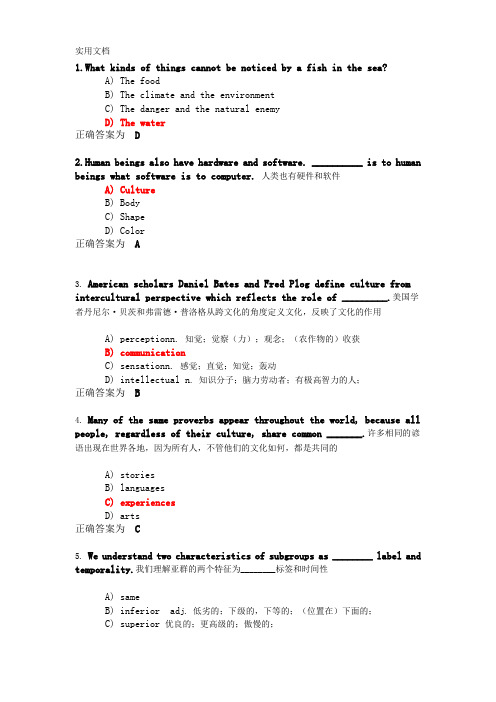
1.What kinds of things cannot be noticed by a fish in the sea?A) The foodB) The climate and the environmentC) The danger and the natural enemyD) The water正确答案为D2.Human beings also have hardware and software. __________ is to human beings what software is to computer. 人类也有硬件和软件A) CultureB) BodyC) ShapeD) Color正确答案为A3.American scholars Daniel Bates and Fred Plog define culture from intercultural perspective which reflects the role of _________.美国学者丹尼尔·贝茨和弗雷德·普洛格从跨文化的角度定义文化,反映了文化的作用A) perceptionn. 知觉;觉察(力);观念;(农作物的)收获B) communicationC) sensationn. 感觉;直觉;知觉;轰动D) intellectual n. 知识分子;脑力劳动者;有极高智力的人;正确答案为B4.Many of the same proverbs appear throughout the world, because all people, regardless of their culture, share common _______.许多相同的谚语出现在世界各地,因为所有人,不管他们的文化如何,都是共同的A) storiesB) languagesC) experiencesD) arts正确答案为C5.We understand two characteristics of subgroups as ________ label and temporality.我们理解亚群的两个特征为________标签和时间性A) sameB) inferior ad j. 低劣的;下级的,下等的;(位置在)下面的;C) superior 优良的;更高级的;傲慢的;D) deviant 不正常的,异常的;离经叛道的正确答案为D6.__________ refers to one’s sense of belonging to a particular culture or ethnic group. It means one’s sense of the culture to which one belongs.指一个人对某一特定文化或民族的归属感。
跨文化交际复习题和答案解析
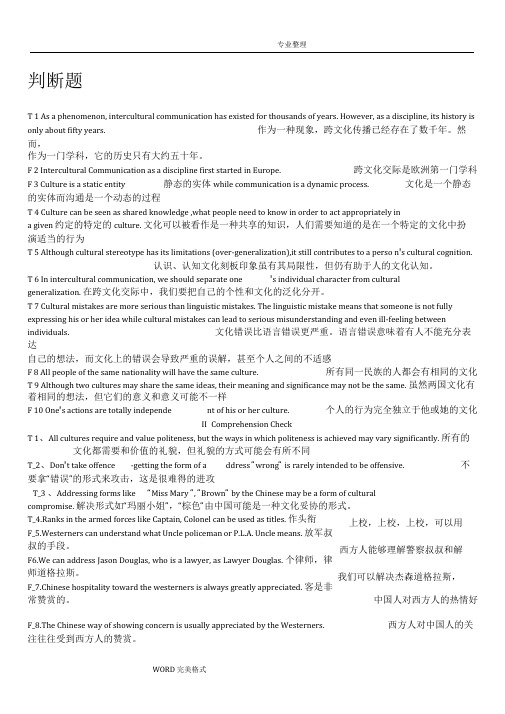
判断题T 1 As a phenomenon, intercultural communication has existed for thousands of years. However, as a discipline, its history is only about fifty years. 作为一种现象,跨文化传播已经存在了数千年。
然而,作为一门学科,它的历史只有大约五十年。
F 2 Intercultural Communication as a discipline first started in Europe.跨文化交际是欧洲第一门学科 F 3 Culture is a static entity 静态的实体 while communication is a dynamic process. 文化是一个静态 的实体而沟通是一个动态的过程T 4 Culture can be seen as shared knowledge ,what people need to know in order to act appropriately ina given 约定的特定的 culture. 文化可以被看作是一种共享的知识,人们需要知道的是在一个特定的文化中扮 演适当的行为T 5 Although cultural stereotype has its limitations (over-generalization),it still contributes to a perso n 's cultural cognition.认识、认知文化刻板印象虽有其局限性,但仍有助于人的文化认知。
T 6 In intercultural communication, we should separate one 's individual character from culturalgeneralization. 在跨文化交际中,我们要把自己的个性和文化的泛化分开。
跨文化交际 number 数字禁忌

1.Numbers have been much influenced by the concept
of Yin and Yang. Yang: The odd numbers ( 奇数)—— The heaven/ male Yin: The even numbers (偶数)——The earth/ female
对于香港人 不能送钟,毯子,白色与红色的 花,这意味着不吉利,礼物数目不能有4,而以8、 6、9为最好。 对于俄罗斯人 送鲜花要送单数,用面包与盐 招待贵客,表示友好和尊敬,最忌讳送钱给别人, 这意味着施舍与侮辱。 对于日本人 接送礼物要双手,不当面打开礼 物,当接受礼物后,再一次见到送礼的人一定会提 及礼物的事并表示感谢,送的礼物忌送梳子,因为 梳子的发音与死相近.礼品包装图案忌讳狐狸(贪 婪),一般人不要送菊花,以为菊花一般是王室专 用花卉。 对于韩国人 到韩国人家里做客,要带一束鲜 花或小礼物,双手奉上,受赠者不宜当面打开礼物, 但不要以外国烟作为礼物相送。
02 Religious Belief P90
Ancient Chinese:
1. Three--- stands for three parts of the universe: Heaven, earth and human. Many idiomatice phrases about three: 三人行, 必有我师焉。 一日不见,如隔三秋。 三生有幸: previous life, present life and next life.
01 National psychology P92
4. Gathering auspicious numbers is a way of life. 收集吉祥数字是一种生活方式。 Lucky numbers can be found everywhere: Gift money, red packets, apartment, floor and even street number. 从生日赠送的礼物,春节红包,到给伴娘的红包,再到人 民居住的公寓、楼层甚至是街道号码。
人教版英语七年级上册Unit9整体教学设计

7.结合学生的实际水平,实施分层教学,关注每个学生的学习进度。对基础较弱的学生,给予个别辅导,提高他们的学习效果。
8.定期进行教学评价,了解学生的学习情况,及时调整教学策略,以提高教学效果。
5.培养学生的爱国情怀,学会用英语向外国朋友介绍中国的文化、历史和传统。
二、学情分析
针对人教版英语七年级上册Unit9的教学内容,学情分析如下:
1.学生年龄特点:七年级学生正处于青春期,好奇心强,求知欲旺盛,对于新鲜事物充满兴趣。在本章节的学习中,可以通过引入跨文化交际的元素,激发学生的学习热情。
2.英语水平:经过前几个单元的学习,学生已具备一定的英语基础,但在词汇和语法方面仍有待提高。因此,在教学过程中,要注意巩固和拓展所学知识,逐步提高学生的语言运用能力。
(三)学生小组讨论
1.教师将学生分成若干小组,每组选择一个国家,要求学生用英语讨论该国家的文化特点、风土人情等。
2.各小组向全班展示讨论成果,其他小组的学生可针对展示内容进行提问,以此提高学生的口语表达能力和跨文化交际意识。
3.教师引导学生运用所学词汇和语法,就“Do you want to have a pen pal from another country? Why?”这一话题展开小组讨论,培养学生的思辨能力和合作精神。
3.写作能力:学会用英语书写书信,表达自己的观点和情感,对学生来说具有一定的挑战性。
(二)教学设想
1.采用情景教学法,引入真实语境,让学生在实际交流中运用所学词汇和语法。例如,组织学生模拟与笔友写信、交流的活动,提高学生的语言实际运用能力。
2.利用多媒体教学资源,如图片、视频等,帮助学生形象地理解不同国家的文化特点,提高学生的阅读理解能力。
跨文化交际试题答案(附翻译)
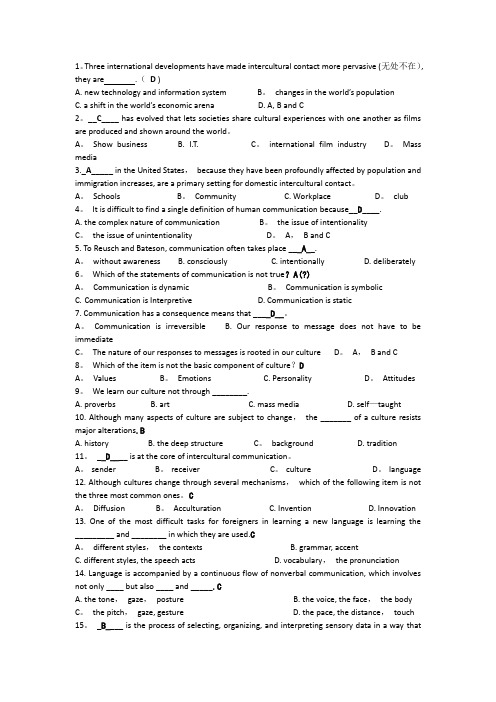
1。
Three international developments have made intercultural contact more pervasive (无处不在), they are .(D )A. new technology and information system B。
changes in the world’s populationC. a shift in the world’s economic arenaD. A, B and C2。
__C____ has evolved that lets societies share cultural experiences with one another as films are produced and shown around the world。
A。
Show business B. I.T. C。
international film industry D。
Mass media3._A_____ in the United States,because they have been profoundly affected by population and immigration increases, are a primary setting for domestic intercultural contact。
A。
Schools B。
Community C. Workplace D。
club 4。
It is difficult to find a single definition of human communication because__D____.A. the complex nature of communication B。
the issue of intentionalityC。
the issue of unintentionality D。
评析贾玉新的《跨文化交际学》

评析贾玉新的《跨文化交际学》自从我读了《跨文化交际学》之后,给我留下了深刻的印象。
特别是书中的一句话:跨文化交际学不仅仅是研究跨文化差异的科学,它还是为人类沟通与理解架设桥梁的一门艺术。
让我们觉得跨文化交际学真是博大精深。
而且从书中,我明白了,西方文化和东方文化有着很大的差异。
所以说,在跨文化交际中,既要了解西方文化,也要了解东方文化,才能更好地去进行交流。
这本书中的第一章是对西方语言文字及文化历史发展的介绍。
我们可以从中看到西方的文字起源于古埃及,然后经过罗马帝国,随后演变成拉丁文。
最后经由英国的工业革命,文字也发生了很大的改变。
然后是德语和法语,都是由拉丁文演变而来的。
所以我觉得,文化和语言是紧密相连的。
而这本书中的第二章是语言与思维。
其实也是告诉我们跨文化交际中语言的重要性。
我觉得学习语言是非常重要的,因为语言直接影响着我们的日常交际。
如果没有正确地运用语言,我们就会很尴尬。
比如有些国家喜欢一言不发。
但在我们中国却恰恰相反,我们总是会说“你懂得”“说得好极了”。
然而这两种语言的用途也是截然不同的。
在中国,多数情况下,不会直接说出自己的想法,即使心里有这样的想法,也会把他们压抑住。
如果遇上脾气不太好的人,甚至会被骂。
可是在法国,则不是这样,即使你心里有这样的想法,也可以直接表达出来。
不会被骂,而且他们会觉得很有趣。
我觉得,两种文化背景的区别,导致了语言的不同。
因此我们在交际时,一定要注意语言的使用。
这样才能让交际更加顺利,更加愉快。
文化因素是语言表达与接受过程中重要的因素。
如果你的汉语水平不高,那么你就无法正确的用汉语来表达自己。
因此,在交际过程中,我们必须要遵守语言的规则。
这本书中的第三章主要是介绍交际过程中的个人态度。
我觉得这一点也是非常重要的。
在进行交际时,一定要保持良好的态度,这样才能和对方友好的交谈,促进彼此的感情。
就如书中所讲的“跨文化交际的实质就是跨越不同的文化界限,达到人与人之间的沟通与理解”。
跨文化交际 Chapter 9 Nonverbal Communication

Narrowly speaking, nonverbal communication (非言语交际) refers to intentional use of nonspoken symbol to communicate a specific message.
Chapter 9 Nonverbal Communication
The Functions of Nonverbal
Communication
a. Replacing
There are situations in which words cannot be used. In a very noisy street, for example, police officer might use hand
One first and very important feng shui career tip talks about your desk position. The desk or table you use for working should be placed in a position that allows you to see the main door. Your desk should never be with your back at the door, since that would be very harmful for your career. And if possible, you should also try to place it in such an angle where you can also see the window.
四年级上册英语教案-Lesson9人教精通版

四年级上册英语教案Lesson 9 人教精通版一、教学目标1. 知识与技能:通过本课的学习,学生能够掌握人教精通版四年级上册英语Lesson 9的基本知识点,包括单词、短语和句型;能够运用所学知识进行简单的英语对话。
2. 过程与方法:通过课堂讲解、互动游戏、角色扮演等多种教学方法,培养学生英语听、说、读、写的能力,提高学生的英语交际能力。
3. 情感态度价值观:激发学生对英语学习的兴趣,培养学生积极参与、团结协作的良好品质,增强学生的跨文化交际意识。
二、教学内容2. 短语:学习描述动物特征的短语,如:a fat cat, a lazy dog, a big fish等。
3. 句型:学习用英语描述动物的外貌、性格和习性,如:This is a , It is 。
三、教学重点与难点1. 教学重点:掌握本课的单词、短语和句型,能够用英语描述动物的外貌、性格和习性。
2. 教学难点:正确运用所学词汇和句型进行英语对话,提高学生的英语口语表达能力。
四、教具与学具准备1. 教具:多媒体课件、单词卡片、动物图片、录音机等。
2. 学具:英语课本、练习册、文具等。
五、教学过程1. 导入:通过展示动物图片,引导学生用中文描述动物的外貌、性格和习性,激发学生的学习兴趣。
2. 新课内容展示:利用多媒体课件,展示本课的单词、短语和句型,引导学生跟读、模仿。
3. 互动游戏:组织学生进行“动物角色扮演”游戏,让学生运用所学知识进行英语对话,提高学生的英语口语表达能力。
4. 小组合作:将学生分成小组,让学生在小组内用英语描述动物的外貌、性格和习性,培养学生的团队协作能力。
5. 巩固练习:布置课堂练习,让学生运用所学知识完成练习题,巩固所学内容。
六、板书设计1. Lesson 9 动物园之旅2. 主要内容:本课的单词、短语和句型3. 示例:This is a , It is七、作业设计1. 听力练习:听录音,完成练习题。
2. 口语练习:与同学进行英语对话,描述动物的外貌、性格和习性。
大学英语跨文化交际chapter9 Intercultural Adaptation

Education — the higher the better
Urban background — city dwellers do better than rural residents
High level of professional skill
General knowledge of the new culture, its history, custom arts, etc.
3. Effects of culture shock
Positive effects
Negative effects
Culture Shock
Text C: Intercultural Adaptation
1. Definition
Intercultural adaptation refers broadly to the process of increasing our level of fitness to meet the demands of a new cultural environment.
用别针之类来固定的蓝色或者黑色长袍,头上一般还 要带白色的便帽
Segregation in the U.S.A
Home
New
Separation Integration Assimilation Marginalization
Segregation
3. Factors Affecting Acculturation
d. Culture fatigue
Culture fatigue is used to describe the physical and psychological discomforts experienced by sojourners trying to adapt to a new culture.
胡文仲《跨文化交际学概论》章节练习(9-12章)【圣才出品】
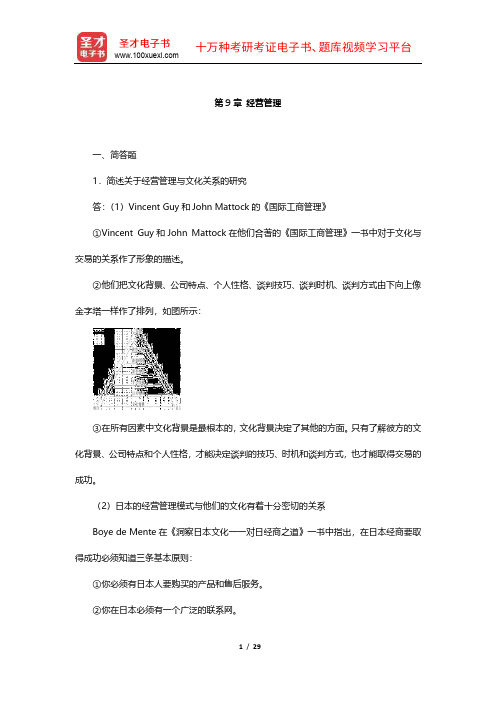
第9章经营管理一、简答题1.简述关于经营管理与文化关系的研究答:(1)Vincent Guy和John Mattock的《国际工商管理》①Vincent Guy和John Mattock在他们合著的《国际工商管理》一书中对于文化与交易的关系作了形象的描述。
②他们把文化背景、公司特点、个人性格、谈判技巧、谈判时机、谈判方式由下向上像金字塔一样作了排列,如图所示:③在所有因素中文化背景是最根本的,文化背景决定了其他的方面。
只有了解彼方的文化背景、公司特点和个人性格,才能决定谈判的技巧、时机和谈判方式,也才能取得交易的成功。
(2)日本的经营管理模式与他们的文化有着十分密切的关系Boye de Mente在《洞察日本文化一一对日经商之道》一书中指出,在日本经商要取得成功必须知道三条基本原则:①你必须有日本人要购买的产品和售后服务。
②你在日本必须有一个广泛的联系网。
③你必须具有足够的跨越文化的交际技能。
(3)路英浩所著《开放前沿的文化震荡》一书对于我国三资企业中的各层次的文化冲突作了细致的分析。
他指出,文化冲突产生在几个不同的层次,有的属于显形文化的层次,有的属于价值观和行为规范方面,有的是认知模式方面的问题,有的甚至是制度性文化的冲突。
(4)西方国家的学者对我国与西方国家在经贸和经营管理方面的差异加强了研究①Lane Kelley和Oded Shenkar合编的《在中国的国际工商业》,书中对于中国的投资环境、经济发展前景、独资合资企业的管理、贸易谈判风格等作了深入的探讨。
②Christopher Enfholm在1994年出版了《在亚洲蓬勃发展的“中国三角”经商》,对于在中国大陆、香港和台湾地区投资的方方面面作了详尽的分析。
美国学者对于日本、墨西哥、澳大利亚与美国的文化分歧也作了大量研究。
2.简述“X—Y”理论。
答:美国社会心理学家麦格雷戈于1957年创立了“X—Y”理论:(1)X理论对于人的本性的假设①一般人生性懒惰,希望工作越少越好。
跨文化交际考试英语

I.定义Chapter 1 CultureCulture(from intellectual perspective)从知性角度定义文化:作为整体的人类智力成就的艺术和其余表现Culture(from anthropologic perspective)从人类学角度定义文化:文化有清楚和模糊的行为模式组成,这些模式经过符号获取并流传,这些符号有人类集体的特别成就组成,包含详细的人工制品。
文化的基本中心由传统思想和与其有关的价值观组成。
Culture(from psychological perspective)从心理学角度定义文化:文化是使一个人类集体成员差别于其余人类集体的思想的整体规划。
Culture(from sociological perspective)从社会学角度定义文化:文化是一种可习得的,鉴于集体的认知模式——包含语言与非语言符号,态度,价值观,信仰和非崇奉系统以及行为。
Culture(from intercultural communication perspective)从跨文化社交学角度定义文化:文化是个人和集体在种族发展过程中所获取的知识,经验,崇奉,价值观,行为,态度,阶级,宗教,时间观,角色,空间观和艺术品的会合。
Culture Identity文化身份:以为自己归属于某一文化或民族集体的感觉。
Subculture亚文化:指存在于主流文化中的文化,其区分往常鉴于经济地位,社会阶层,民族,种族或地理地区。
Co-culture共文化——指拥有独到的社交特色,感知特色,价值观,崇奉和行为,差别于其余集体,社团以及主流文化的集体或社团。
Subgroup 亚集体——有关于亚文化和共文化集体,亚集体往惯例模不大,也不一定有文化集体时代相传累积的价值观点和行为模式。
Chapter 2 Communication and Intercultural Communication1.Sender/Source信息发出者/信息源:指传达信息的人2.Message 信息:只惹起信息接受者反响的任何信号。
跨文化交际学概论__胡文仲版
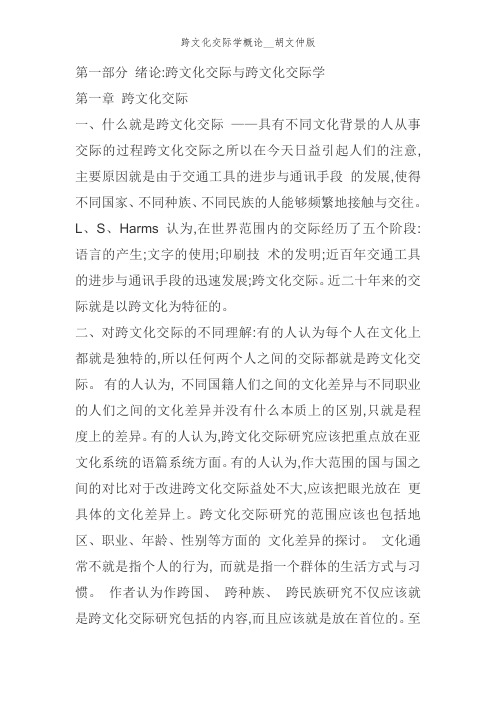
第一部分绪论:跨文化交际与跨文化交际学第一章跨文化交际一、什么就是跨文化交际——具有不同文化背景的人从事交际的过程跨文化交际之所以在今天日益引起人们的注意, 主要原因就是由于交通工具的进步与通讯手段的发展,使得不同国家、不同种族、不同民族的人能够频繁地接触与交往。
L、S、Harms 认为,在世界范围内的交际经历了五个阶段:语言的产生;文字的使用;印刷技术的发明;近百年交通工具的进步与通讯手段的迅速发展;跨文化交际。
近二十年来的交际就是以跨文化为特征的。
二、对跨文化交际的不同理解:有的人认为每个人在文化上都就是独特的,所以任何两个人之间的交际都就是跨文化交际。
有的人认为, 不同国籍人们之间的文化差异与不同职业的人们之间的文化差异并没有什么本质上的区别,只就是程度上的差异。
有的人认为,跨文化交际研究应该把重点放在亚文化系统的语篇系统方面。
有的人认为,作大范围的国与国之间的对比对于改进跨文化交际益处不大,应该把眼光放在更具体的文化差异上。
跨文化交际研究的范围应该也包括地区、职业、年龄、性别等方面的文化差异的探讨。
文化通常不就是指个人的行为, 而就是指一个群体的生活方式与习惯。
作者认为作跨国、跨种族、跨民族研究不仅应该就是跨文化交际研究包括的内容,而且应该就是放在首位的。
至于地区、阶级、阶层、职业、性别、年龄等不同层次的差异也应该给予关注。
至于个人之间的差异的研究只就是在我们把她们当做群体的代表时才有意义。
在研究一个国家的文化特点时, 我们的眼光首先应集中在它的主流文化主流文化上,其次才注意它的亚文化与地区文化的特点。
主流文化-主流文化-亚文化-地区文化-小群体文化(不同年龄、职业、性别群体的文化)三、第二章跨文化交际学跨文化交际学在美国Intercultural Communication (与人类学、心理学、传播学关系密切)1、首先在美国兴起。
美国有来自各个国家的移民,有各自的文化系统与风俗习惯,逐渐在美国社会形成了多元文化的格局;美国与各国交往频繁。
中日跨文化交际案例

中日跨文化交际案例1. 日本留学生在中国大学的交流活动一位日本留学生来到中国大学参加学术交流活动,与中国大学生进行了交流。
在交流过程中,他们分享了各自国家的文化特点和习俗。
通过这次活动,日本留学生更深入地了解了中国文化,同时也让中国大学生对日本文化有了更多的了解。
2. 中日企业间的商务会议一家中国企业和一家日本企业进行了商务会议,双方通过会议讨论合作事宜,并就合作项目达成了共识。
在会议中,双方代表团互相介绍了各自企业的情况,讨论了合作的具体细节以及合作模式。
通过这次商务会议,中日企业之间建立了良好的合作关系。
3. 中日学生间的语言交流一群中国学生和一群日本学生组织了一次语言交流活动。
在活动中,他们使用各自的母语进行交流,并互相教授对方的语言。
通过这次活动,中日学生们互相学习了对方的语言和文化,增进了彼此的了解和友谊。
4. 中日游客在旅游景点的交流在中国的一个著名旅游景点,有很多来自日本的游客。
他们与当地的中国游客进行了交流,互相分享了旅行的经历和感受。
通过这次交流,中日游客们对彼此的国家和文化有了更深入的了解,增进了友谊。
5. 中日翻译团队的合作一家中国公司和一家日本公司进行了合作,需要进行文件的翻译工作。
双方组建了一个翻译团队,由中日双方的翻译人员共同完成翻译任务。
在合作过程中,双方翻译人员通过讨论和交流,解决了翻译中的难题,确保翻译质量和准确性。
6. 中日艺术家的文化交流一位中国艺术家和一位日本艺术家进行了文化交流活动。
他们互相分享了各自的艺术作品和创作理念,并进行了艺术作品的展示和评论。
通过这次交流,中日艺术家们互相学习和借鉴了对方的创作方法和风格,推动了两国艺术的交流与发展。
7. 中日大学间的学术合作一所中国大学和一所日本大学进行了学术合作,双方共同开展了研究项目。
研究团队由中日双方的教授和学生组成,进行了研究课题的讨论和实验。
通过这次合作,两所大学在学术研究上取得了共同的成果,提升了双方的学术水平。
跨文化交际导论(含答案)

对外经济贸易大学远程教育学院2010-2011学年第二学期跨文化交际导论(英) 复习大纲课程名称: ENG338a【跨文化交际导论(英)】考核方式: 开卷笔试[占总分的70%]复习范围:以指定教材(第1-9章)为主,课件内容为辅。
试题形式:客观试题50 题,每题2分,题型共三种形式:I. Definition Matching.Match the terms with their definitions. (给术语配对定义,10题,1题2分,共20分)II. True-False. Circle A if the statement is true; circle B if it is false. (判断各句是否正确,20题,1题2分,共40分)III. Multiple Choice. Circle the letter corresponding to the correct response. (在所给的4个选项中选择一个最恰当的答案,20题,1题2分,共40分)复习方法:●认真学习指定教材,结合课件的教学内容,全面复习,从总体上掌握这门跨学科课程的特点;●理解各讲中的主要教学内容,即每讲开始前的Learning Objectives,不要死记硬背,重理解、勤思考、细观察,从跨文化交际的角度对文化差异进行分析、记忆、总结;●要力图将跨文化交际理论与交往实践相结合,将西方文化交际的理论与实践与中国的本土文化相结合,通过大量真实生动的交际的成败案例的学习,提高分析问题和解决问题的能力;●参考指定教材各章后的练习以及书后附的两套模拟自测题,术语定义配对题、是非题和多项选择题可帮助复习检验对所学内容熟悉的掌握程度,熟悉客观题型,问答题和案例有助于进一步理解。
跨文化交际导论课程期末考试模拟题(红色答案来自答疑系统,供参考)Ⅰ. Match the following terms with their definition. (20%)1.the study of the way that people use physical space to convey messages. C2.the way in which time is used in a culture. A3.the actual practice of concepts or beliefs. B4.the total activity of learning one's culture. D5.social principles, goals, or standards accepted by persons in a culture. EA.Temporal language/ chronemicsB.Behavior communicationC.Spatial language/proxemicsD.EnculturationE.Values6. between nations and governments rather than individuals A7. perceptions about certain groups of people or nationalities C8. a learned organization of rules for making choices and for solving conflicts D9. volume, pitch, and rate that affects message meaning E10. the idea that every act of communication must happen in some sort of surroundings BA.internationalB.contextC.valueD.stereotypesE.paralanguageⅡ.True or FalseMark A if the statement is true; mark B if it is false.11.When engaging in small talk with a person of another culture, remember that discussing one'sfamily and political discussions are inappropriate topics in all cultures. B12.Transference of pragmatic rules refers to the transference of corresponding words andsentence structure from mother tongue to target language. A13.Since all cultures share the same basic values, cultures attach the same meanings to thesebasic values. B14.Primary values are the most important. A15.Some countries officially recognize religious rituals that affect business encounters. A16.People in the United States place a greater emphasis on history and do not like change ascompared with people of Asian and Latin cultures. B17.The behavior of John lying in bed and reading a novel is a two-way contact. B18.Linear Model is one of the earliest and still the most useful attempts to describe thecommunication process A19.International communication takes place between such groups as African Americans andLatin Americans. B20.Intercultural communication as a discipline was not established in U.S. until the 1980s. B21.Without the cultural rules people also can behave properly. B22.Culture is not something we are born with, but rather it is learned. A23.Kisses and hugs are not appropriate greeting behavior between males of any culture. B24.In Germany, business gifts are usually exchanged at the beginning of formal negotiations. B25.New and improved technology, growth in the world’s population, and shifts in the globaleconomic arena have increased globalization. A26.No country is completely self-sufficient. A27.All cultures require and value politeness, but the ways in which the politeness is achievedmay vary significantly. A28.International English is used only by businesspeople who practice English as a secondlanguage. B29.International communication takes place between such groups as African Americans andLatin Americans. B30.The process of learning culture is always conscious. B31.Ethnocentrism leads to a objective evaluation of how another culture conducts its dailybusiness. A32.The hierarchy is a theory has not been proven applicable to all the countries. A33.Cultures may differ, but communication practices do not differ. B34.Culture is ongoing and subject to change. A35.The term “co-cultures” suggests the inequality betwe en groups. B36.Chinese is an example of linear language. Amunication barriers are caused by the same communication having different meanings indifferent cultures. A38.New and improved technology, growth in the world’s population, and shifts in the globaleconomic arena have increased globalization. A39.Power distance in the United States is comparatively high. B40.Pragmatic failure is the inability to understand what is meant by what is said. A41.Values motivate people. A42.Attitudes are the same thing as values. A43.Eventually, with the spread of technology everyone will have the same values. B44.In order to understand a culture's values, you need only to learn the "do's and taboos" of behavior in that culture. A45.Social class is unimportant in negotiator selection. B46. Relationship building is important in Arab and Latin America. A47. Achievement in countries with high masculinity scores is expressed through material possessions. B48. Acculturation is the socialization process of how people learn their own culture through what is said and done. B48. Consumers in high uncertainty avoidance cultures tend to perceive little or no risk in the purchase of new products.49. Intercultural communication competence requires sufficient awareness, knowledge, motivations, and skills. A50. Values are enduring attitudes about the preferability of one belief over another.51. Cultures are so different that we will never be able to communicatesuccessfully. B52. Transference of pragmatic rules refers to the transference of corresponding words andsentence structure from mother tongue to target language. A53. Today intercultural communication encounters are different from encountersof the past. A54. All languages can, in their own way, distinguish between present and pastevents, but they may not feel that this distinction is important enough to createa system of verb tense. A55. Kisses and hugs are not appropriate greeting behavior between males of anyculture. B56. Values are learned; they are not innate. A57. Long-term-oriented cultures are characterized by patience, perseverance, and respect forone’s elders and ancestors. A58. Nonverbal aspects are very important in low-context cultures. A59. When engaging in small talk with a person of another culture, remember that discussingone's family and political discussions are inappropriate topics in all cultures. B60. Chinese is an example of a linear language. A61. Language serves as the only guide to how a culture perceives reality. B61. All languages can, in their own way, distinguish between present and past events, but they maynot feel that this distinction is important enough to create a system of verb tense. A 62. Globalization is the ability of a corporation to take a product and market it anywhere in theworld. A63. In order for intercultural negotiation to be successful, the parties must provide for a win-losesituation. B64. In some countries, using gifts to assure success in sealing an agreement is an accepted way ofdoing business. A65. As they become globalized, companies will have to train their work forces to deal with multiculturality. A66. People from countries with strong uncertainty avoidance are more likely to remain closefriends in spite of differing opinions. A66. Even if the language is common to both cultures, one culture may restrict the meaning of certain words. A67. In their business letters, the French do not usually apologize for mistakes. B68. Achievement in countries with high masculinity scores is expressed throughmaterial possessions. B69. Acculturation is the socialization process of how people learn their own culturethrough what is said and done. B70. In the Japanese society, knowing the rank of people with whom you conduct business is veryimportant. A、Ⅲ. Multiple ChoicesMark the letter corresponding to the correct response.1. What country ranks the lowest on individualism? CA.AustraliaB. CanadaC.GuatemalaD. United States2.Proponents of which attitude feel that self-interest is an appropriate goal?A.Uncertainty-reductionB. AttributionC. IndividualismD. Collectivism3. Language is important because it AA.helps us shape concepts, controls how we think, and controls how weperceive others.B. allows us to be understood by foreigners.C.is determined by colonialism.D.is stable, easily understood, and free of diversity.4. Which of the following countries uses high-context language? CA.CanadaB. GermanyC.JapanD. United States5. Which one of the following statements is not among the functions of culture offered by Dressler and Carns? CA.Culture makes it possible to anticipate how others in our society are likely to respond toour actions.B.Culture enables us to communicate with others through a language that we have learnedand that we share in common.C.Culture leads to better understanding in business.D.Culture provides the knowledge and skill necessary for meeting sustenance needs.6. Culture can be classified in all the following ways except Ba)Artifact, concepts and behaviorb)Positive culture and negative culturec) A level of values and a level of resultant behaviour or artifacts of some formd)An invisible level and a visible level7. "The part was found defective, and it was determined that there is a defect in the button causingit not to fit into the chassis." This statement is an example of a DA.linear explanation.B.verbose explanation.C.nonlinear explanation.D.why explanation.8. Which of the following would be an example of a translation problem? Ding the intention of the speaker rather than the actual words in the translation.B.Qualifying slang terms.C.Not translating conversation taboos.ing a word for which no exact word or concept is available in the second language.9.Which of the following greeting way is somewhat unique to Chinese? BA. Giving regards to others.B. Commenting on something.C. Using address forms as greeting.D. Using nonverbal forms as greeting.10.The styles of paragraph development for oriental countries could be described as DA. a vertical straight line.B. zigzagged lines.C. a circular, spiral lineD. a digressive, back-and-forth zigzag.11. Which statement referring to thought patterns is incorrect? CA. Asians typically use the inductive method of reasoning.B. Thought patterns impact oral communication.C.When using the deductive method of reasoning, one starts with the facts and goes togeneralizations.D. Recognizing different thought patterns is important in negotiation with differentcultures.12. Which statement is incorrect? BA. Costly business blunders are often the result of a lack of knowledge of anotherculture's nonverbal communication patterns.B. Processes of reasoning and problem solving are the same in all cultures.C. Attitudes toward time and use of space convey nonverbal messages inintercultural encounters.D. When in another culture, an appropriate caution would be to watch the behavior ofthe persons you are talking with and match their style.13.People of which type of society believe their truth is the only truth?A.IndividualisticB. Strong-uncertainty avoidanceC.CollectivisticD.Weak-uncertainty avoidance14.What we are willing to die for and what we deem worthy of protection is determined byour ___? BA.belief systemB.value systemC.attitude processesD.social organizations15. Slang is generally DA.understood by everyone.B.spoken by the masses.C.easily translated.ed by subgroups.16. Nonverbal communication does not includeA. chromatics.B. chronemics.C. haptics.D. semantics.17. As a result of globalization, new issues facing corporations includeA.cultural differences in work ethicsB.stereotyping by members of international teamsC.personnel who are overqualified for overseas positionsD. a & b18. The classic The Silent Language published in 1959, was written byA.KluckhohnB.BenedictC.MeadD.Edward Hall19. Which of the following has occurred due to advances in technology?A.People are beginning to spend more time with family members.B.The number of relationships we have with people have decreased.C.People have more frequent contact with people from other cultures.D.People are gaining a clearer sense of who they really are.20. It is important to study intercultural communication becauseA. it is a necessary and worthwhile pursuit.B. most people are more alike than they realize.C. cultural differences bring people together.D. intercultural communication is subjective.21. ______ are the most important. AA. Primary valuesB.Secondary valuesC.Tertiary valuesD.None of the above22. In cultures that tend toward individualism, what aspects are encouraged? DA. competitionB.personal goalsC.individual rightsD.all of the above23. We learn culture DA.from folk tales, legends and mythsB.in conscious or unconscious waysC.through art and mass mediaD.all of the above24. Which statement least represents U.S. values? CA. U.S. Americans value directness over indirectness.B. U.S. Americans value time management over leisure.C. U.S. Americans value history over planning for the future.D.U.S. Americans value equality over inequality.25. Which statement highlights weak uncertainty avoidance?A.One group's truth should not be imposed on others.B.Scientific opponents cannot be personal friends.C.Citizen protest should be repressed.D.Negative attitudes are expressed toward young people26. Which time orientation is held by cultures that value living and realizing the potential of today?CA.past orientation to timeB.immutable orientation to timeC.present orientation to timeD.mutable orientation to time27. Which of the following value orientations emerged from the Chinese research team?A.long-term versus short-term orientationB.masculinity/femininity orientationC.preferred form of activity orientationD.uncertainty avoidance orientation28. The notions of masculinity and femininityA.are universal for every culture across time.B.are not just based on biological differences.C.have not changed through the ages.D.have well-established and understood meanings.29. From what areas of the world do most of today's immigrants to the United States come? and Latin AmericaB.Mexico and Eastern EuropeC.Haiti and ChinaD.Eastern Europe and the Middle East30. The China Association for Intercultural Communication is held ______.A. once a yearB. every two yearsC. every three yearsD. every four years31. Who of the following would feel most comfortable with silence during a conversation? Amanager from _____. CE.the United StatesF.GermanyG.Great BritainH.Japan32 Which statement related to work attitudes is incorrect? AA.U.S. attitudes toward work are more relaxed than those in Europe.B.In the United States, hard work is applauded and often rewarded.C.The Japanese attitude toward work is very group-oriented.D.In the United States, the attitude toward work is ingrained from an early age.33. Which statement referring to thought patterns is incorrect? DA.The structure of a language affects the perceptions of reality of its speakersB.The structure of a language influences thought patterns and worldviews of its speakersnguage functions as a way of shaping one’s experienceD.There is a general agreement concerning the validity of Sapir-Whorf hypothesis34. Which statement is incorrect? Dnguage is a reflection of the environmentnguage is reflection of cultural valuesnguage is a reflection of culture, and culture is a reflection of language.D. A good mastering of a foreign language equals a complete understanding of its culture.35. Which statement referring to thought patterns is incorrect? Ca. Asians typically use the inductive method of reasoning.b. Thought patterns impact oral communication.c.When using the deductive method of reasoning, one starts with the facts and goesto generalizations.d. Recognizing different thought patterns is important in negotiation with differentcultures.36. Which statement is incorrect? Ba. Costly business blunders are often the result of a lack of knowledge of anotherculture's nonverbal communication patterns.b. Processes of reasoning and problem solving are the same in all cultures.c.Attitudes toward time and use of space convey nonverbal messages inintercultural encounters.d.When in another culture, an appropriate caution would be to watch thebehavior of the persons you are talking with and match their style.37. Language is important because it Aa.helps us shape concepts, controls how we think, and controls how weperceive others.b.allows us to be understood by foreigners.c.is determined by colonialism.d.is stable, easily understood, and free of diversity.38. Which of the following countries uses high-context language? DB.CanadaC.GermanyD.JapanE.United States39. Slang is generally HE.understood by everyone.F.spoken by the masses.G.easily translated.ed by subgroups.40. General guidelines to follow when conversing with someone from another culture includeall of the following except: ca. politics is a safe topic in most cultures.b. avoid telling jokes.c. avoid personal questions.d. keep the conversation positive.41. Which statement best describes an incorrect handshake? ca. In the U.S., a handshake should be firm.b. An Asian handshake is usually gentle.c. Germans repeat a brusque handshake upon arrival and departure.d. A British handshake is firm and repeated frequently.42. Language is important because it ee.helps us shape concepts, controls how we think, and controls how weperceive others.f.allows us to be understood by foreigners.g.is determined by colonialism.h.is stable, easily understood, and free of diversity.43. Which of the following countries uses high-context language? HF.CanadaG.GermanyH.JapanI.United States44. Slang is generally LI.understood by everyone.J.spoken by the masses.K.easily translated.ed by subgroups.45. Nonverbal communication does not includea. chromatics.b. chronemics.c.haptics.d.semantics.46. "The part was found defective, and it was determined that there is a defect in the buttoncausing it not to fit into the chassis." This statement is an example of a HE.linear explanation.F.verbose explanation.G.nonlinear explanation.H.why explanation.47. Which of the following would be an example of a translation problem? Hing the intention of the speaker rather than the actual words in the translation.F.Qualifying slang terms.G.Not translating conversation taboos.ing a word for which no exact word or concept is available in the secondlanguage.48. Which statement highlights weak uncertainty avoidance?a. One group's truth should not be imposed on others.b. Scientific opponents cannot be personal friends.c. Citizen protest should be repressed.d. Negative attitudes are expressed toward young people.49. The main idea of the Sapir-Whorf Hypothesis is thatnguage is just a device for reporting a person's experience.b.two languages can represent the same social reality.c.the social reality can be conveyed to a person who does not speak thelanguage.nguage functions as a way of shaping a person's experience.50. Many multinational firms find that cultural shock can be alleviated by Da. sending only top executives abroad.b. sending only young, single associates on overseas assignments.c. testing associates to see who is most qualified.d. selecting employees for overseas assignments who possess certain personal andprofessional qualifications.。
跨文化交际Unit 9 Intercultural Personhood

3. Ethnocentrism
…is characterized by the belief that one’s own group or culture is superior to all others.
Ethnocentrism refers to the belief that one' s culture is primary to all explanations of reality. We learn ethnocentrism very early in life, and primarily on the unconscious level. So it might be the major barrier to intercultural communication. (Samovar, 1998)
可是梁祝靠越剧传播显然有局限性而一曲梁祝靠越剧传播显然有局限性而小提琴协奏曲就让外国人受了感动这个中国爱情故事也就在世界上传播开了
Intercultural Personhood
An Integration of Eastern and Western Perspectives
We’re going to discuss…
Of all the American values, individualism is probably the most basic. So some people refer to the American culture as "I" culture, as individuals are emphasized. Self-reliance "stand on their own feet".
跨文化交际课程教学大纲
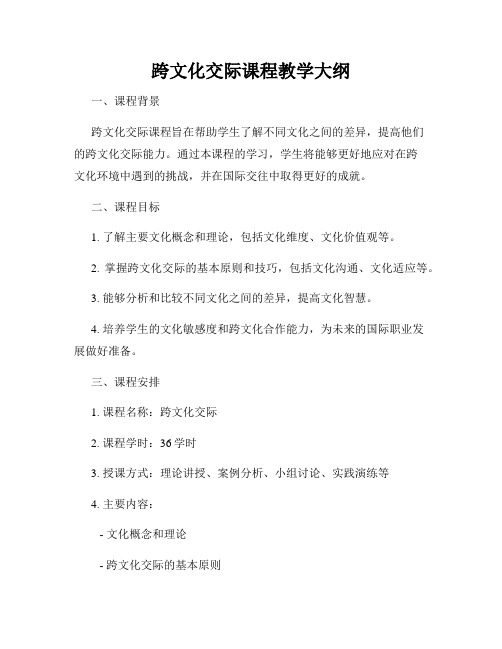
跨文化交际课程教学大纲一、课程背景跨文化交际课程旨在帮助学生了解不同文化之间的差异,提高他们的跨文化交际能力。
通过本课程的学习,学生将能够更好地应对在跨文化环境中遇到的挑战,并在国际交往中取得更好的成就。
二、课程目标1. 了解主要文化概念和理论,包括文化维度、文化价值观等。
2. 掌握跨文化交际的基本原则和技巧,包括文化沟通、文化适应等。
3. 能够分析和比较不同文化之间的差异,提高文化智慧。
4. 培养学生的文化敏感度和跨文化合作能力,为未来的国际职业发展做好准备。
三、课程安排1. 课程名称:跨文化交际2. 课程学时:36学时3. 授课方式:理论讲授、案例分析、小组讨论、实践演练等4. 主要内容:- 文化概念和理论- 跨文化交际的基本原则- 文化差异分析与比较- 文化冲突与解决- 跨文化沟通技巧- 跨文化适应能力培养- 跨文化合作案例研究四、评估方式1. 期中考试2. 课堂表现3. 作业4. 期末论文五、教材及参考书目1. 主教材:《跨文化交际》2. 参考书目:- 《跨文化交际能力培养》 - 《全球商务交际实务》 - 《国际文化比较》六、教学团队本课程教师将由具有丰富跨文化交际经验和教学经验的专业人士担任,确保学生能够获得高质量的教学服务。
七、总结跨文化交际课程是培养学生国际化视野和文化广度的重要课程,通过本课程的学习,希望能够帮助学生更好地适应多元文化社会,提高国际竞争力,为未来的职业生涯奠定坚实基础。
愿学生在这门课程中有所收获,不断提升自我跨文化交际能力。
跨文化交际导论(含答案)

对外经济贸易大学远程教育学院2009-2010学年第二学期跨文化交际导论(英) 复习大纲课程名称: ENG338a【跨文化交际导论(英)】考核方式: 开卷笔试[占总分的70%]复习范围:以指定教材(第1-9章)为主,课件内容为辅。
试题形式:客观试题50 题,每题2分,题型共三种形式:I. Definition Matching.Match the terms with their definitions. (给术语配对定义,10题,1题2分,共20分)II. True-False. Circle A if the statement is true; circle B if it is false. (判断各句是否正确,20题,1题2分,共40分)III. Multiple Choice. Circle the letter corresponding to the correct response. (在所给的4个选项中选择一个最恰当的答案,20题,1题2分,共40分)复习方法:●认真学习指定教材,结合课件的教学内容,全面复习,从总体上掌握这门跨学科课程的特点;●理解各讲中的主要教学内容,即每讲开始前的Learning Objectives,不要死记硬背,重理解、勤思考、细观察,从跨文化交际的角度对文化差异进行分析、记忆、总结;●要力图将跨文化交际理论与交往实践相结合,将西方文化交际的理论与实践与中国的本土文化相结合,通过大量真实生动的交际的成败案例的学习,提高分析问题和解决问题的能力;●参考指定教材各章后的练习以及书后附的两套模拟自测题,术语定义配对题、是非题和多项选择题可帮助复习检验对所学内容熟悉的掌握程度,熟悉客观题型,问答题和案例有助于进一步理解。
跨文化交际导论课程期末考试模拟题(答案供参考)Ⅰ. Match the following terms with their definition. (20%)1.the study of the way that people use physical space to convey messages. B2.the way in which time is used in a culture. A3.the actual practice of concepts or beliefs. E4.the total activity of learning one's culture. C5.social principles, goals, or standards accepted by persons in a culture. DA.Temporal language/chronemicsB.Behavior communicationC.Spatial language/proxemicsD.EnculturationE.Values6. between nations and governments rather than individuals A7. perceptions about certain groups of people or nationalities C8. a learned organization of rules for making choices and for solving conflicts B9. volume, pitch, and rate that affects message meaning E10. the idea that every act of communication must happen in some sort of surroundings DA.internationalB.contextC.valueD.stereotypesE.paralanguageⅡ.True or FalseMark A if the statement is true; mark B if it is false.11.When engaging in small talk with a person of another culture, remember that discussing one'sfamily and political discussions are inappropriate topics in all cultures. B12.Transference of pragmatic rules refers to the transference of corresponding words andsentence structure from mother tongue to target language. A13.Since all cultures share the same basic values, cultures attach the same meanings to thesebasic values. B14.Primary values are the most important. A15.Some countries officially recognize religious rituals that affect business encounters. A16.People in the United States place a greater emphasis on history and do not like change ascompared with people of Asian and Latin cultures. B17.The behavior of John lying in bed and reading a novel is a two-way contact. B18.Linear Model is one of the earliest and still the most useful attempts to describe thecommunication process A19.International communication takes place between such groups as African Americans andLatin Americans. B20.Intercultural communication as a discipline was not established in U.S. until the 1980s. A21.Without the cultural rules people also can behave properly. B22.Culture is not something we are born with, but rather it is learned. A23.Kisses and hugs are not appropriate greeting behavior between males of any culture. B24.In Germany, business gifts are usually exchanged at the beginning of formal negotiations.A25.New and improved technology, growth in the world’s population, and shifts in the globaleconomic arena have increased globalization. A26.No country is completely self-sufficient. A27.All cultures require and value politeness, but the ways in which the politeness is achievedmay vary significantly. A28.International English is used only by businesspeople who practice English as a secondlanguage. B29.International communication takes place between such groups as African Americans andLatin Americans. B30.The process of learning culture is always conscious. B31.Ethnocentrism leads to a objective evaluation of how another culture conducts its dailybusiness. A32.The hierarchy is a theory has not been proven applicable to all the countries. A33.Cultures may differ, but communication practices do not differ. B34.Culture is ongoing and subject to change. A35.The term “co-cultures” suggests the inequal ity between groups. B36.Chinese is an example of linear language. Amunication barriers are caused by the same communication having different meanings indifferent cultures. B38.New and improved technology, growth in the world’s population, and shifts in the globaleconomic arena have increased globalization. A39.Power distance in the United States is comparatively high. B40.Pragmatic failure is the inability to understand what is meant by what is said. A41.Values motivate people. A42.Attitudes are the same thing as values. A43.Eventually, with the spread of technology everyone will have the same values. B44.In order to understand a culture's values, you need only to learn the "do's and taboos" of behavior in that culture. A45.Social class is unimportant in negotiator selection. B46. Relationship building is important in Arab and Latin America. A47. Achievement in countries with high masculinity scores is expressed through material possessions. B48. Acculturation is the socialization process of how people learn their own culture through what is said and done. A48. Consumers in high uncertainty avoidance cultures tend to perceive little or no risk in the purchase of new products . A49. Intercultural communication competence requires sufficient awareness, knowledge, motivations, and skills. A50. Values are enduring attitudes about the preferability of one belief over another. B51. Cultures are so different that we will never be able to communicatesuccessfully. B52. Transference of pragmatic rules refers to the transference of corresponding words andsentence structure from mother tongue to target language. A53. Today intercultural communication encounters are different from encountersof the past. A54. All languages can, in their own way, distinguish between present and pastevents, but they may not feel that this distinction is important enough to createa system of verb tense. A55. Kisses and hugs are not appropriate greeting behavior between males of anyculture. B56. Values are learned; they are not innate. A57. Long-term-oriented cultures are characterized by patience, perseverance, and respect forone’s elders and ancestors. A58. Nonverbal aspects are very important in low-context cultures. B59. When engaging in small talk with a person of another culture, remember that discussingone's family and political discussions are inappropriate topics in all cultures. A60. Chinese is an example of a linear language. B61. Language serves as the only guide to how a culture perceives reality. A61. All languages can, in their own way, distinguish between present and past events, but they maynot feel that this distinction is important enough to create a system of verb tense. A 62. Globalization is the ability of a corporation to take a product and market it anywhere in theworld. A63. In order for intercultural negotiation to be successful, the parties must provide for a win-losesituation. A64. In some countries, using gifts to assure success in sealing an agreement is an accepted way ofdoing business. B65. As they become globalized, companies will have to train their work forces to deal with multiculturality. A66. People from countries with strong uncertainty avoidance are more likely to remain closefriends in spite of differing opinions. B66. Even if the language is common to both cultures, one culture may restrict the meaning of certain words. A67. In their business letters, the French do not usually apologize for mistakes. A68. Achievement in countries with high masculinity scores is expressed throughmaterial possessions. B69. Acculturation is the socialization process of how people learn the ir own culturethrough what is said and done. A70. In the Japanese society, knowing the rank of people with whom you conduct business is veryimportant. A、Ⅲ. Multiple ChoicesMark the letter corresponding to the correct response. C1. What country ranks the lowest on individualism?A.AustraliaB. CanadaC.GuatemalaD. United States2.Proponents of which attitude feel that self-interest is an appropriate goal? CA.Uncertainty-reductionB. AttributionC. IndividualismD. Collectivism3. Language is important because it AA.helps us shape concepts, controls how we think, and controls how weperceive others.B. allows us to be understood by foreigners.C.is determined by colonialism.D.is stable, easily understood, and free of diversity.4. Which of the following countries uses high-context language? CA.CanadaB. GermanyC.JapanD. United States5. Which one of the following statements is not among the functions of culture offered by Dressler and Carns? CA.Culture makes it possible to anticipate how others in our society are likely to respond toour actions.B.Culture enables us to communicate with others through a language that we have learnedand that we share in common.C.Culture leads to better understanding in business.D.Culture provides the knowledge and skill necessary for meeting sustenance needs.6. Culture can be classified in all the following ways except Ba)Artifact, concepts and behaviorb)Positive culture and negative culturec) A level of values and a level of resultant behaviour or artifacts of some formd)An invisible level and a visible level7. "The part was found defective, and it was determined that there is a defect in the button causingit not to fit into the chassis." This statement is an example of a DA.linear explanation.B.verbose explanation.C.nonlinear explanation.D.why explanation.8. Which of the following would be an example of a translation problem? Ding the intention of the speaker rather than the actual words in the translation.B.Qualifying slang terms.C.Not translating conversation taboos.ing a word for which no exact word or concept is available in the second language.9.Which of the following greeting way is somewhat unique to Chinese? BA. Giving regards to others.B. Commenting on something.C. Using address forms as greeting.D. Using nonverbal forms as greeting.10.The styles of paragraph development for oriental countries could be described as DA. a vertical straight line.B. zigzagged lines.C. a circular, spiral lineD. a digressive, back-and-forth zigzag.11. Which statement referring to thought patterns is incorrect? CA. Asians typically use the inductive method of reasoning.B. Thought patterns impact oral communication.C.When using the deductive method of reasoning, one starts with the facts and goes togeneralizations.D. Recognizing different thought patterns is important in negotiation with differentcultures.12. Which statement is incorrect? BA. Costly business blunders are often the result of a lack of knowledge of anotherculture's nonverbal communication patterns.B. Processes of reasoning and problem solving are the same in all cultures.C. Attitudes toward time and use of space convey nonverbal messages inintercultural encounters.D. When in another culture, an appropriate caution would be to watch the behavior ofthe persons you are talking with and match their style.13.People of which type of society believe their truth is the only truth? AA.IndividualisticB. Strong-uncertainty avoidanceC.CollectivisticD.Weak-uncertainty avoidance14.What we are willing to die for and what we deem worthy of protection is determined byour ___? BA.belief systemB.value systemC.attitude processesD.social organizations15. Slang is generally DA.understood by everyone.B.spoken by the masses.C.easily translated.ed by subgroups.16. Nonverbal communication does not include DA. chromatics.B. chronemics.C. haptics.D. semantics.17. As a result of globalization, new issues facing corporations include DA.cultural differences in work ethicsB.stereotyping by members of international teamsC.personnel who are overqualified for overseas positionsD. a & b18. The classic The Silent Language published in 1959, was written by DA.KluckhohnB.BenedictC.MeadD.Edward Hall19. Which of the following has occurred due to advances in technology? BA.People are beginning to spend more time with family members.B.The number of relationships we have with people have decreased.C.People have more frequent contact with people from other cultures.D.People are gaining a clearer sense of who they really are.20. It is important to study intercultural communication because CA. it is a necessary and worthwhile pursuit.B. most people are more alike than they realize.C. cultural differences bring people together.D. intercultural communication is subjective.21. ______ are the most important. AA. Primary valuesB.Secondary valuesC.Tertiary valuesD.None of the above22. In cultures that tend toward individualism, what aspects are encouraged? DA. competitionB.personal goalsC.individual rightsD.all of the above23. We learn culture DA.from folk tales, legends and mythsB.in conscious or unconscious waysC.through art and mass mediaD.all of the above24. Which statement least represents U.S. values? CA. U.S. Americans value directness over indirectness.B. U.S. Americans value time management over leisure.C. U.S. Americans value history over planning for the future.D.U.S. Americans value equality over inequality.25. Which statement highlights weak uncertainty avoidance? DA.One group's truth should not be imposed on others.B.Scientific opponents cannot be personal friends.C.Citizen protest should be repressed.D.Negative attitudes are expressed toward young people26. Which time orientation is held by cultures that value living and realizing the potential of today? CA.past orientation to timeB.immutable orientation to timeC.present orientation to timeD.mutable orientation to time27. Which of the following value orientations emerged from the Chinese research team? AA.long-term versus short-term orientationB.masculinity/femininity orientationC.preferred form of activity orientationD.uncertainty avoidance orientation28. The notions of masculinity and femininity BA.are universal for every culture across time.B.are not just based on biological differences.C.have not changed through the ages.D.have well-established and understood meanings.29. From what areas of the world do most of today's immigrants to the United States come? D and Latin AmericaB.Mexico and Eastern EuropeC.Haiti and ChinaD.Eastern Europe and the Middle East30. The China Association for Intercultural Communication is held ______. BA. once a yearB. every two yearsC. every three yearsD. every four years31. Who of the following would feel most comfortable with silence during a conversation? Amanager from _____. CE.the United StatesF.GermanyG.Great BritainH.Japan32 Which statement related to work attitudes is incorrect? AA.U.S. attitudes toward work are more relaxed than those in Europe.B.In the United States, hard work is applauded and often rewarded.C.The Japanese attitude toward work is very group-oriented.D.In the United States, the attitude toward work is ingrained from an early age.33. Which statement referring to thought patterns is incorrect? DA.The structure of a language affects the perceptions of reality of its speakersB.The structure of a language influences thought patterns and worldviews of its speakersnguage functions as a way of shaping one’s experienceD.There is a general agreement concerning the validity of Sapir-Whorf hypothesis34. Which statement is incorrect? Dnguage is a reflection of the environmentnguage is reflection of cultural valuesnguage is a reflection of culture, and culture is a reflection of language.D. A good mastering of a foreign language equals a complete understanding of its culture.35. Which statement referring to thought patterns is incorrect? Ca. Asians typically use the inductive method of reasoning.b. Thought patterns impact oral communication.c.When using the deductive method of reasoning, one starts with the facts and goesto generalizations.d. Recognizing different thought patterns is important in negotiation with differentcultures.36. Which statement is incorrect? Ba. Costly business blunders are often the result of a lack of knowledge of anotherculture's nonverbal communication patterns.b. Processes of reasoning and problem solving are the same in all cultures.c.Attitudes toward time and use of space convey nonverbal messages inintercultural encounters.d.When in another culture, an appropriate caution would be to watch thebehavior of the persons you are talking with and match their style.37. Language is important because it Aa.helps us shape concepts, controls how we think, and controls how weperceive others.b.allows us to be understood by foreigners.c.is determined by colonialism.d.is stable, easily understood, and free of diversity.38. Which of the following countries uses high-context language? DB.CanadaC.GermanyD.JapanE.United States39. Slang is generally HE.understood by everyone.F.spoken by the masses.G.easily translated.ed by subgroups.40. General guidelines to follow when conversing with someone from another culture includeall of the following except: Ca. politics is a safe topic in most cultures.b. avoid telling jokes.c. avoid personal questions.d. keep the conversation positive.41. Which statement best describes an incorrect handshake? Ca. In the U.S., a handshake should be firm.b. An Asian handshake is usually gentle.c. Germans repeat a brusque handshake upon arrival and departure.d. A British handshake is firm and repeated frequently.42. Language is important because it Ee.helps us shape concepts, controls how we think, and controls how weperceive others.f.allows us to be understood by foreigners.g.is determined by colonialism.h.is stable, easily understood, and free of diversity.43. Which of the following countries uses high-context language? AF.CanadaG.GermanyH.JapanI.United States44. Slang is generally LI.understood by everyone.J.spoken by the masses.K.easily translated.ed by subgroups.45. Nonverbal communication does not include Da. chromatics.b. chronemics.c.haptics.d. semantics.46. "The part was found defective, and it was determined that there is a defect in the buttoncausing it not to fit into the chassis." This statement is an example of a HE.linear explanation.F.verbose explanation.G.nonlinear explanation.H.why explanation.47. Which of the following would be an example of a translation problem? Hing the intention of the speaker rather than the actual words in the translation.F.Qualifying slang terms.G.Not translating conversation taboos.ing a word for which no exact word or concept is available in the secondlanguage.48. Which statement highlights weak uncertainty avoidance? Ba. One group's truth should not be imposed on others.b. Scientific opponents cannot be personal friends.c. Citizen protest should be repressed.d. Negative attitudes are expressed toward young people.49. The main idea of the Sapir-Whorf Hypothesis is that Dnguage is just a device for reporting a person's experience.b.two languages can represent the same social reality.c.the social reality can be conveyed to a person who does not speak thelanguage.nguage functions as a way of shaping a person's experience.50. Many multinational firms find that cultural shock can be alleviated by Da. sending only top executives abroad.b. sending only young, single associates on overseas assignments.c. testing associates to see who is most qualified.d. selecting employees for overseas assignments who possess certain personal andprofessional qualifications.。
跨文化交际考试重点归纳

跨文化交际考试重点归纳work Information Technology Company.2020YEAR题型:part/, True or False,30% (提醒学生在答题时要正确的画A,错的画B) 15x2 (除第八章)part II. Multiple Choices 20%, 20x1.(2,4,5 细节)Part III. Cultural Puzzles 10% (与课后习题中的cultrual puzzles 类似,不过是四个选项,范围为课后习题中的cultural puzzles和我们在每个单元划出的重点案例)5X2. Part IV. Term Matching 15% (名词解释,从备选的terms中选择与其对应的definitions,要考到的terms都已经发给大家)15x1.Part V. Short-Answer Questions 15% (简答题,范围在我们划过的重点内)5X3. Part VI. Case Study 10% (课外案例分析,阅读一个案例,回答三个小问题,题LI 不会超出课内讲解的内容)10x1.要补充的重点为pll4, (E・ Discover the mea ning of some comm on gestures in English), pl29, (B・ What are the characteristics of feminine talk and masculine talk respectively)另外让学生深入研究unit 5和Unit 2, Unit 4(culturally-loaded words),以及每单元的重点案例,以及单元后面的练习A, B(划过的问答题),C (Euphemism Understanding),以及E (cultural puzzles)TermsUnit 11.Economic globalization:经济全球化the integration of national economies into the in ter national economy through trade, foreign direct in vestme nt, capital flows, migration, and the spread of technology.2.Global village:地球村All the different parts of the world form one community linked together by electronic communications, especially the Internet.3.Melting pot:大熔炉a socio-cultural assimilation of people of different backgrounds and nationalities・4.Cultural Diversity:文化多样性the mix of people from various backgrounds in the labor force with a full mix of cultures and sub-cultures to which members belong・5.Intercultural communication:跨文化交际communication between people whose cultural percepti ons and symbol systems are disti net eno ugh to alter thecommu nication eve nt.6.Culture文化a learned set of shared interpretations about beliefs, values, and norms, which affect the behavior of a relatively large group of people・7.Enculturation:文化适应all the activities of learning one's culture are called enculturatio n.8.Acculturation:文化传入the process which adopts the changes brought about by another culture and develops an increased similarity between the two cultures・9.Ethnocentrism:民族优越感the belief that your own cultural background is superior.munication:交际to share with or to make common, as in giving to another a part or share of your thoughts, hopes, and knowledge・(以下为components of commu nication)PS: what is the cHfference between encoding & decoding Encoding is the process of putting an idea into a symbol. Decoding is the process of assigning meaning to the symbols received・11.Source 发送信息的人The source is the person with an idea he or she desires to commu nicate ・12.Encoding 编码Unfortunately (or perhaps fortunately), humans are not able to share thoughts directly. Your communication is in the form of a symbol represent!ng the idea you desire to communicate. Encoding is the process of putting an idea into a symbol.13.Message 信息The term message identifies the encoded thought・ Encoding is the process, the verb; the message is the resulting object・14.Channel 渠道The term channel is used technically to refer to the means by which the encoded message is transmitted・ The channel or medium, then, may be print, electronic, or the light and sou nd waves of the face-to-face communicati on. 15.Noise 噪音The term noise technically refers to anything that distorts the message the source encodes・16.Receiver 接的人The receiver is the person who attends to the message・17.Decoding 解码Decoding is the opposite process of encoding and just as much an active process・ The receiver is actively involved in the communication process by assigning meaning to the symbols received・18.Receiver response 反馈The receiver is the person who attends to the message・Receiver response refers to anything the receiver does after having attended to and decoded the message・19.Feedback 反馈Feedback refers to that portion of the receiver response of which the source has knowledge and to which the source attends and assigns meaning. 20.Context 语境The final comp on ent of communicatio n is con text ・ Gen erally, context can be defined as the environ merit in which the commu nication takes place and which helps define the communication.精讲案例Case 1 (p.l) case 2 (p.2)思考题lx what are the four trends that lead to the development of the global village P8-9+简要说明convenient transportation systemsinnovative communication systemseconomic globalization widespread migrations2. What are the three ingredients of culture?Artifacts(the material and spiritual products people produce)Behavior(what they do)Concept(what they think)3.How to understand cultural iceberg? P7The aspects of culture that are explicit,visible,taught.The aspects of culture that are intangible and not taught directly.4.What are the characteristic of culture?Shared JearnedqynamCethnocentric(文化中心、主义),5.What are the characteristic of communication?Dynamicjrreversible^ymboli^systemati^tra nsactional’c on textualUnit 2-411.Pragmatics:语用学the study of the effect that language has on human perceptions and behavior.12.Semantics:语意the study of the meaning of words・13.Denotation:字面意思the literal meaning or definition of a word …the explicit, particular, defined meaning.14.Connotation:弦夕卜之音the suggestive meaning of a word …all the values, judgments, and beliefs implied by a word, the historical and associative accretion of the unspoken sign讦icance behind the literal meaning.15.Taboo:禁忌语some objects, words or actions that are avoided by a particular group of people, or in certain culture for religious or social reasons.16.Euphemism:委婉语the act of substituting a mild, indirect, or vague term for one considered harsh, blunt, or offensive・精讲案例Case 1, case 2(p.l7) case 4 (p. 19) Case 2 (p 43) case 3 (p.45) Case 1 (p.67) case 3 (p.69)思考题6.How is Chinese addressing different from American addressing? (p.33)The Americans tend to address only with given names while the Chinese may use the full name・ Even when the full names are used in some formal occasions by the Americans’the given names would be placed before the surname while the Chinese would do the opposite・Chinese often extend kinship terms to people not related by blood or marriage while the America ns seldom do so.The Chinese tend to address the people with titles but in English only a few occupation or titles could be used.7.What are the social functions of compliments (p.60)(答案p50 第一段) Compliments have a series of social functions: creating or reinforcing solidarity, greeting people, expressing thanks or congratulations, encouraging people, softening criticism, starting a conversation, or even overcoming embarrassment.Unit 517.Chronemics:时间学The study of how people perceive and use time・18.Monochronic time:—元时间概念paying attention to and doing only one thing ata time・19.Polychronic time:多元时间概念being involved with many things at once.20.Proxemics:空间学the perception and use of space.21.Kinetics:身势学the study of body language22.Paralanguaga 辅助语言invol ving sou nds but not words and lying between verbal and non verbal commu nicatio n.精讲案例case 1 (p. 85) case 3 (p.87) case 5, 6 (p.90) case 7 (p.91) 思考题8.What are the different features of M-time and P-time? (p97)M-time means paying attention to and doing only one thing at a time・M-time is noted for its emphasis on schedules, segme ntati on and prompt ness .It features one event at a time. Time is perceived as a linear structure and something concrete tangible・P-time means being involved with many things at once.P-time is less rigid and clock-bound ・ It features several activities at the sametime .It is more flexible and human-centered・9.what is the meaning of common gestures in English P114 (答案P233-234)Unit 6精讲案例case 1 (p.115) case 2 (p.116) p.124-126 中的小案例思考题9.How is gender different from sex? (p.129)(答案P.119/120)10.What has influenced the gender socialization?There are two primary in fluences on gen der socialization: family communication, particularly between mothers and children and recreational interaction among childre n.11.What are the six principles for effective cross-gender communication (p. 129)(答案127-128)Suspend judgement, recognize the validity of different communication styles, provide translation cues, enlarge your own communication style, suspend judgement.12.what are the characteristics of feminine talk and masculine talk respectively?P123Unit 7精讲案例case 1 (p.137) case 3 (p.139)13.Discuss the concepts of high context culture and low con text culture (pl53)(结合最后一个单元中ppt 的讲解,了解high-context culture 和low-context culture 两个概念)A high-context communication or message is one in which most of the information is already in the person, while very little is in the coded, explicitly transmitted part of the message・ In high-context cultures, verbal messages have little meaning without the surrou nding con text, which includes the overall relationship between all the people engaged in communication.(沉默是金;一切尽在不言中;心有灵犀一点通)A low con text communicati on is the just the opposite; i.e. the mass of the information is vested in the explicit code・High-context culture low-context cultureJapanese Chinese Korean American ............. G erman German・SwissUnit 923.A planetary culture:行星文化a culture that integrates eastern mysticism with western scienee and rationalism・24.Intercultural person:跨文化的人represents some one whose cognitive, affective, and behavioral characteristics are not limited but open to growth beyond the psychological parameters of his or her own culture・思考题13.What are the American/Chinese cultural values like in terms of Cultural Orientation put forward by Kluckhohn and Strodtbeck? (ppt 中的补充内容)As far as the human nature is concerned, American culture holds that it is evil but perfectible through hard work. As to the relation of man to nature, they think mankind can conquer nature・ They also have a linear time concept and therefore they are future-oriented・ They focus on doing and think that only actions can solve the problem. They are quite individualistic and therefore they focus less on the ben efits of the group ・As far as the human nature is concerned, Chinese culture holds that it is good but corruptible without proper education. As to the relation of man to nature, they think mankind can live in harmony with nature・ They also have a cyclical time concept and therefore they are past-oriented. They have a being-and-becoming attitude towards activity and think that man should keep an inner peace as nothing is eternal. They are quite collective and therefore they focus more on the ben efits of the group ・14.Identify the features of each of four Hofstede's cultural dimensions and use them to analyze the cases (案例分析)。
- 1、下载文档前请自行甄别文档内容的完整性,平台不提供额外的编辑、内容补充、找答案等附加服务。
- 2、"仅部分预览"的文档,不可在线预览部分如存在完整性等问题,可反馈申请退款(可完整预览的文档不适用该条件!)。
- 3、如文档侵犯您的权益,请联系客服反馈,我们会尽快为您处理(人工客服工作时间:9:00-18:30)。
‘Is this sweet or salty?’ ‘Is this food sweet or savory?’ Savory is a general word used to describe main course dishes like meat, and vegetables as well as others like cheese and crackers (salty biscuits). A cocktail party may offer savories (small portions of slightly salty foods) as well as drinks and sweets. Note that the most common word for the sweet food at the end of a meal is dessert, but it may also be called sweet or pudding.
Note: as English dinners usually revolve around one main course rather that many different dishes, hosts often ask beforehand whether guests do not like anything to avoid everyone being disappointed. There is also a sizeable minority of vegetarians, and hosts would wish to know about this before planning meals. If Jean were a vegetarian she certainly would not enjoy the planned ‘roast’. A roast is a large piece of meat such as a leg of lamb or a chicken cooked inside an oven. It is usually served with potatoes and one or two other vegetables such as cabbage 邀请 / Inviting
Dear James, Teaching in China is a real pleasure, but people here can sometimes be a little mean with their hospitality. Yesterday I was invited to an official banquet in the evening by the university. As you know, I enjoy Chinese food and would have loved to have gone, but for some reason Janiet was not included in the invitation. Naturally I couldn’t accept and leave the dear old wife at home so I had to make an excuse to get out of it. Can’t think why they should want to snub her in that way, but it has made both of us feel that we are not really welcome…
Situation 3 In a western meal, you’re offered a second helping but you have already had enough. What would you say? ‘No thanks. I’m full.’
‘No thanks. I’m full.’ This is fine with family or close colleagues. If you wish to be more polite in more formal situations it might be better to say something a little less direct, such as ‘That was delicious but I’ve already had plenty, thanks’. back
Note: Generally speaking for invitations to any meal taking place in the evening, ranging from those given at someone’s home through to dining out together or attending formal banquets, both husband and wife will be included. This is not expected in the case of mid-day meals, probably because couples often work in different places and some jobs involve taking a working lunch with clients or colleagues. Here in China, however, it is quite common for only the husband or wife to be invited to a meal, wither in work units or between friends, and neither husband nor wife will feel offended if one of them is not invited.
9.2 礼貌 / Politeness
Impolite and Over-polite
Impolite Case 1: After ordering food in a restaurant, one foreigner, for example, was reported as saying, ‘the dishes are quite good here; these dishes are quite famous’ instead of apologizing for the poor quality and quantity of the food. Chinese feel that it is impolite for the foreigner to claim the dishes are good, when there were only ten dishes ordered (for four people), and they were, in fact, rather ordinary. ‘I’m sorry. The restaurant is a little bit small and the dishes are just so-so, but I hope you’ll enjoy yourself.’
Michael: Hi, Peter, how’s things? Peter: Fine, fine. And you? Michael: Oh, so-so. Look, what are you up to this Friday? We were wondering if you and Jean would like to come over to our place for a bite to eat. Peter: Sounds lovely. Any particular time? Michael: Oh, say about eight. Oh, by the way, is there anything either of you don’t like? Peter: No, eat anything really. Oh, now I come to think of it, Jean’s a bit off spicy food at present, had a bit of a tummy from an Indian restaurant we went to last week. Michael: No problem. We were thinking of having a roast.
跨文化交际学
第九章 社会交往
9.1 好客/ Hospitality 9.2 礼貌 / Politeness 9.3 邀请 / Inviting 9.4 礼物 / Gifts 9.5 Eye Contact 9.6 Body Distance
9.1 好客/ Hospitality
Chinese: Hospitality means pressing you to accept the offer. West: Hospitality is shown by giving you freedom to choose whatever you really want.
Case 2: A foreigner don’t accompany guests to the gate upon leave-taking. Chinese: show greater degrees of concern and care toward guests. (Many Chinese think foreigners fail to express proper levels of concern and care for guests. Some complained of impoliteness ) West: give guests the chance to choose what is their favorite.
